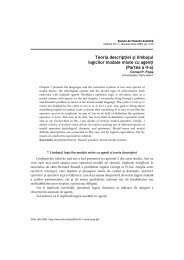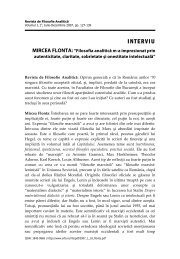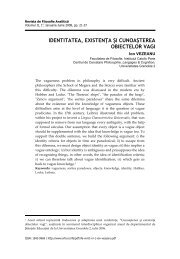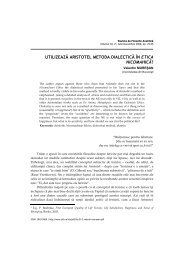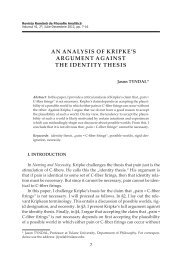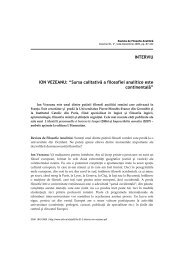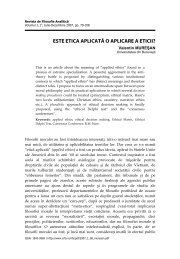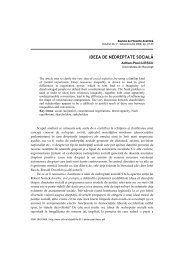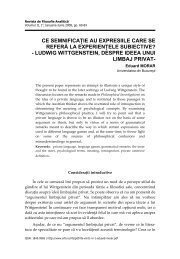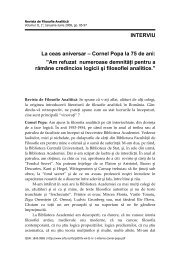brandom's lx theory of logic and the challenge of autonomous ...
brandom's lx theory of logic and the challenge of autonomous ...
brandom's lx theory of logic and the challenge of autonomous ...
Create successful ePaper yourself
Turn your PDF publications into a flip-book with our unique Google optimized e-Paper software.
Br<strong>and</strong>om’s Lx Theory <strong>of</strong> Logic <strong>and</strong> <strong>the</strong> Challenge <strong>of</strong> Autonomous Vocabularies...<br />
to produce assertively tokenings <strong>of</strong> <strong>the</strong> new form „if p <strong>the</strong>n q.“ What is<br />
required, <strong>the</strong>n, is first that this new sort <strong>of</strong> response be hooked up responsively<br />
to <strong>the</strong> previously discriminable stimulus, so that it is asserted<br />
just in those cases where <strong>the</strong> inference from p to q would have been<br />
responded to as a good one. […] For <strong>the</strong> consequences <strong>of</strong> application,<br />
we need ano<strong>the</strong>r bit <strong>of</strong> response substitution. The system can already, by<br />
hypo<strong>the</strong>sis, respond to some stimuli by treating an inference as good or<br />
bad. We must now hook up that response to a new stimulus-kind. The<br />
system must respond to its assertion <strong>of</strong> <strong>the</strong> conditional «if p <strong>the</strong>n q» by<br />
treating <strong>the</strong> inference from p to q as a good one—for instance, by being<br />
disposed to endorse q assertionally if it is disposed to endorse p assertionally.<br />
These new differential responsive abilities, achieved by reshuffling<br />
prior ones, <strong>the</strong>n settle <strong>the</strong> statetable that specifies how <strong>the</strong> system<br />
is able to respond to different presented stimuli : non-<strong>logic</strong>al sentences<br />
<strong>and</strong> inferences involving <strong>the</strong>m, <strong>and</strong> now also conditional sentences <strong>and</strong><br />
inferences involving <strong>the</strong>m— paradigmatically, modus ponens. In a clear<br />
sense, <strong>the</strong>n, <strong>the</strong> capacity to distinguish good from bad inferences involving<br />
non-<strong>logic</strong>al sentences is (PP-) sufficient for <strong>the</strong> ability to deploy conditionals<br />
involving those sentences.“ (BSD, 45) 6<br />
Such relations can be diagrammatically represented, in <strong>the</strong> case <strong>of</strong> <strong>the</strong> conditional<br />
vocabulary, as follows :<br />
V conditionals<br />
Res 1<br />
: VV 1-5<br />
V 1<br />
4 : PV-suff<br />
5 : VP-suff<br />
1 : PV-suff<br />
2 : PV-nec<br />
P conditionals<br />
P AlgEl 3 : PP-suff<br />
P inferring<br />
P ADP<br />
Fig. 1. Elaborated-explicating (LX) conditionals 7<br />
6<br />
Something is missing from this analysis. When accepting S’s move from p to q, I can be in one<br />
<strong>of</strong> <strong>the</strong> two situations : on <strong>the</strong> one h<strong>and</strong>, I can be also committed to p ; on <strong>the</strong> o<strong>the</strong>r h<strong>and</strong> I might<br />
reject p because, for example, p is incompatible with r, for which I have an entitlement. If I am<br />
committed to p, I will say „p, <strong>the</strong>n q.“ This formulation is appropriate because in this way I<br />
make explicit <strong>the</strong> fact that I am committed to p. The use <strong>of</strong> <strong>the</strong> conditional locution „<strong>the</strong>n,“ in addition,<br />
makes explicit <strong>the</strong> semantic connection between p <strong>and</strong> q. In <strong>the</strong> second case, what I want<br />
to do is to express <strong>the</strong> semantic connection from p to q, but not necessarily <strong>the</strong> fact that I am committed<br />
to p. This shows that besides acceptance <strong>and</strong> rejection, ano<strong>the</strong>r attitude is needed, one<br />
that be <strong>the</strong> right target in order to attach <strong>the</strong> response „If p, <strong>the</strong>n q.“ Lance <strong>and</strong> White (2007) calls<br />
such a speech act „hypo<strong>the</strong>sizing,“ <strong>and</strong> argue that is essential in attributing intentional states.<br />
7<br />
Diagram taken from BSD, 46. Given <strong>the</strong> resultant relation 5, <strong>the</strong> conditional vocabulary is a<br />
pragmatic metavocabulary for <strong>the</strong> inferential practice.<br />
63



